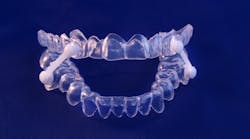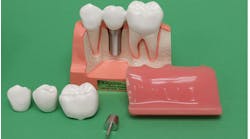In the ever-evolving health-care landscape, staying ahead of the curve is important for a dental practice. One way that dentists can expand their business and enhance patient care is by adding oral appliance therapy (OAT) to their practice. This noninvasive treatment can significantly boost a dental practice’s growth. It allows dentists to offer comprehensive patient care, addressing not only patients’ dental needs but also their sleep-related issues.
Related reading:
8 steps to maximize the benefits of adding a new service
Clear aligners: A journey of calculable change
Dr. Pam's Practice Picks: Incorporating new services
What is oral appliance therapy?
Oral appliance therapy helps manage certain sleep-disordered breathing issues, most notably obstructive sleep apnea (OSA). Oral appliance therapy uses a mandibular advancement device (MAD) which gently holds the lower jaw forward, preventing it (and the tongue) from falling back during sleep to avoid airway obstruction and maintain proper airflow. This helps reduce snoring and other sleep apnea symptoms, improves sleep quality, and reduces the associated health risks.
Oral appliances are FDA approved to help treat patients with mild to moderate sleep apnea.
The advantages of oral appliance therapy include1:
- It’s noninvasive. Unlike continuous positive airway pressure (CPAP) therapy, which requires wearing a mask over the nose and/or mouth, oral appliances are noninvasive and more comfortable for patients.
- It’s convenient. Oral appliances are portable and easy to use, making them convenient for travel and use in various sleeping environments.
- It’s quiet and discreet. Oral appliances don't produce the noise associated with CPAP machines. This makes them less disruptive to bed partners and more discreet to wear.
- It results in improved compliance. Some people find oral appliances more tolerable and are more likely to use them consistently compared to CPAP machines.
- It provides comprehensive care. Many people with sleep apnea also clench or grind their teeth or have a TMJ disorder. With oral appliance therapy, patients can manage all these conditions at once.2
Oral appliance therapy expands your patient base
Offering oral appliance therapy can make a dental practice attractive to a broader range of patients in need of specialized sleep care. For example, sleep apnea patients seeking alternatives to traditional treatments or who don’t tolerate CPAP machines can find relief through oral appliances.3 Highlighting the comprehensive nature of a practice’s services can draw in patients looking for one-stop solutions.
Additionally, oral appliances are customized to fit each patient's clinical situation and needs. They also allow for comprehensive dentistry and treatment plans while giving patients a better quality of life.
Get your team on board with oral appliance therapy
From receptionists to hygienists, everyone in a dental practice should get on board with sleep medicine and OAT. Dentists should communicate the importance of incorporating OAT into their practice’s offerings. They should explain how it aligns with their practice’s values and goals and how it contributes to patient satisfaction and practice growth.
Dentists should consider training their team members to ensure that they are well versed in the different aspects of OAT. This helps build their confidence in caring for patients in need of these services. Additionally, dentists should discuss any concerns or misconceptions team members may have about OAT. Addressing these concerns can alleviate any reservations they might have and make them more receptive to offering the treatment.
Collaborate with other health-care professionals
A huge advantage of offering sleep medicine services such as OAT is the opportunity to collaborate with other health-care professionals. Working in conjunction with sleep specialists and other medical practitioners such as ENTs, myofunctional therapists, body workers, and speech and language pathologists helps create a network of interdisciplinary care.
Dentists can screen their patients for sleep-disordered breathing and then collaborate with sleep specialists for diagnosis and comprehensive treatment plans. Building relationships with local sleep specialists, ENTs, and MDs is a crucial component of adding OAT to a dental practice. These relationships enhance the patient experience and outcome. Plus, they foster a mutual exchange of expertise and may boost referrals.
Create a smooth and efficient billing system
Medical billing can be tough, so dentists interested in OAT should create a workflow that works for them. They should research and understand the insurance plans that cover OAT and verify whether a patient’s plan covers the treatment and to what extent. This helps dentists communicate effectively with patients about their potential costs.
Promote your services and educate your patients
As dentists introduce OAT to their practices, they should let their community and existing patients know. Consider incorporating patient education initiatives. Workshops, webinars, and informational pamphlets can educate patients about OAT’s benefits. Dentists could also use social media platforms to reach new and existing patients by sharing sleep tips, success stories, infographics, and testimonials.
Adding OAT to a dental practice is a strategic move that yields lots of benefits. This noninvasive treatment option can drive a dental practice’s growth, increase its revenue, and enhance patients’ health. By offering innovative solutions and staying attuned to patients’ needs, dentists can position their practices for long-term success.
Editor's note: This article appeared in the November 2023 print edition of Dental Economics magazine. Dentists in North America are eligible for a complimentary print subscription. Sign up here.
References
- Oral appliance therapy. American Academy of Dental Sleep Medicine. https://www.aadsm.org/oral_appliance_therapy.php
- Kleoppel J. Benefits of oral sleep appliances you haven’t considered. Center for TMJ & Sleep Apnea. September 28, 2020. https://www.tmjsleepapnea.com/blog/oral-sleep-appliances-benefits/
- Holley AB, Dombrowsky JW. Predicting a successful response to oral appliance therapy: advancing knowledge one model at a time. J Clin Sleep Med. 2018;14(11):1837-1838. doi:10.5664/jcsm.7472
- What is oral appliance therapy? American Academy of Sleep Medicine. October 2020. https://sleepeducation.org/patients/oral-appliance-therapy/
Meghna Dassani, DMD, has practiced dentistry for more than two decades and is passionate about the role dentists play in whole-body health. She earned her DMD at Boston University Goldman School of Dental Medicine and opened Dassani Dentistry in Houston, Texas, in 2011. You can learn more on her website meghnadassani.com.






